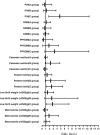Adverse obstetric and perinatal outcomes in 2333 singleton pregnancies conceived after different endometrial preparation protocols: a retrospective study in China
- PMID: 35501733
- PMCID: PMC9063113
- DOI: 10.1186/s12884-022-04682-3
Adverse obstetric and perinatal outcomes in 2333 singleton pregnancies conceived after different endometrial preparation protocols: a retrospective study in China
Abstract
Backgroup: Frozen-thawed embryo transfer is rising worldwide. One adverse effect of programmed frozen embryo transfer (FET) reported in some studies is an increased risk of adverse obstetric and perinatal outcomes. Meanwhile, body mass index (BMI) also has adverse effect on obstetric and perinatal outcomes. In this study, we investigated that the influence of different endometrial preparation protocols on obstetric and perinatal outcomes and the role of BMI in it.
Method: This retrospective cohort study included 2333 singleton deliveries after frozen-thaw embryo transfer at our centre between 2014 and 2021, including 550 cycles with programmed FET, 1783 cycles with true natural cycle FET (tNC-FET). In further analysis according to BMI grouped by Asian criterion, group A (18.5 kg/m2 ≤ BMI < 24.00 kg/m2) included 1257 subjects, group B (24 kg/m2 ≤ BMI < 28.00 kg/m2) included 503 subjects and group C (BMI ≥ 28 kg/m2) included 573 subjects. Baseline characteristics of the two groups were compared and analyzed. Binary logistic regression analyses were performed to explore the association between obstetric and perinatal outcomes and endometrial preparation protocols.
Results: There were no significant differences in the placenta previa, gestational diabetes mellitus(GDM), preterm premature rupture of membranes (PPROM), cesarean section (CS) and macrosomia between the tNC-FET and programmed FET groups (P > 0.05). The programmed FET cycles were associated to a higher risk of pregnancy-induced hypertension (PIH) compared with the tNC-FET cycles (7.3% vs 4.4%, crude OR 1.71[1.16-2.54]; adjusted OR 1.845[1.03-3.30]). After dividing the patients into three groups according to the BMI, The programmed FET cycles were associated to a higher risk of PIH in group C (14.4% vs 6.2%, crude OR 2.55 [1.42-4.55]; adjusted OR 4.71 [1.77-12.55]) compared with the tNC-FET cycles. But there was no statistically significant difference in group A and group B. Programmed FET group compared with the tNC-FET group, the risk of PIH increase as the body mass index increase.
Conclusion: This study showed a tendency toward increasing risk of PIH in programmed FET cycle compared with the tNC-FET cycle, and the risk of PIH increases as BMI increases. Increased risk of preterm birth and low birth weight is linked to increased risk of PIH.
Keywords: Frozen embryo transfer (FET); Natural cycle; Obstetric outcome; Perinatal outcome; Programmed cycle.
© 2022. The Author(s).
Conflict of interest statement
No author has any potential conflict of interest.
Figures
Similar articles
-
Obstetric and perinatal outcomes following programmed compared to natural frozen-thawed embryo transfer cycles: a systematic review and meta-analysis.Hum Reprod. 2022 Jun 30;37(7):1619-1641. doi: 10.1093/humrep/deac073. Hum Reprod. 2022. PMID: 35553678
-
Adverse obstetric and perinatal outcomes in 1,136 singleton pregnancies conceived after programmed frozen embryo transfer (FET) compared with natural cycle FET.Fertil Steril. 2021 Apr;115(4):947-956. doi: 10.1016/j.fertnstert.2020.10.039. Epub 2021 Jan 16. Fertil Steril. 2021. PMID: 33461756 Clinical Trial.
-
The influence of embryo stage on obstetric complications and perinatal outcomes following programmed compared to natural frozen-thawed embryo transfer cycles: a systematic review and meta-analysis.Front Endocrinol (Lausanne). 2023 Aug 16;14:1186068. doi: 10.3389/fendo.2023.1186068. eCollection 2023. Front Endocrinol (Lausanne). 2023. PMID: 37664838 Free PMC article.
-
Young women were associated with higher risk of hypertensive disorders of pregnancy and cesarean section from hormone replaced cycles in frozen-thawed embryo transfer: a retrospective study of 5316 singleton deliveries.Front Endocrinol (Lausanne). 2023 Sep 5;14:1238887. doi: 10.3389/fendo.2023.1238887. eCollection 2023. Front Endocrinol (Lausanne). 2023. PMID: 37772083 Free PMC article.
-
Thick endometrium is associated with hypertensive disorders of pregnancy in programmed frozen-thawed embryo transfers: a retrospective analysis of 2,275 singleton deliveries.Fertil Steril. 2024 Jan;121(1):36-45. doi: 10.1016/j.fertnstert.2023.10.028. Epub 2023 Oct 31. Fertil Steril. 2024. PMID: 37914068
Cited by
-
Obstetric and neonatal outcomes after natural versus artificial cycle frozen embryo transfer and the role of luteal phase support: a systematic review and meta-analysis.Hum Reprod Update. 2023 Sep 5;29(5):634-654. doi: 10.1093/humupd/dmad011. Hum Reprod Update. 2023. PMID: 37172270 Free PMC article.
References
-
- Maheshwari A, Raja E, Bhattacharya S. Obstetric and perinatal outcomes after either fresh or thawed frozen embryo transfer: an analysis of 112,432 singleton pregnancies recorded in the human fertilisation and embryology authority anonymized dataset. Fertil Steril. 2016;106(7):1703–1708. doi: 10.1016/j.fertnstert.2016.08.047. - DOI - PubMed
MeSH terms
LinkOut - more resources
Full Text Sources
Medical
Miscellaneous


